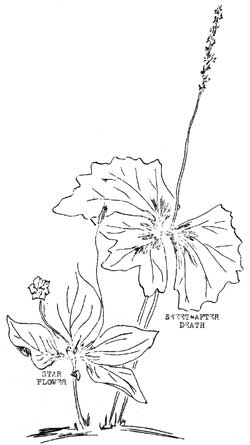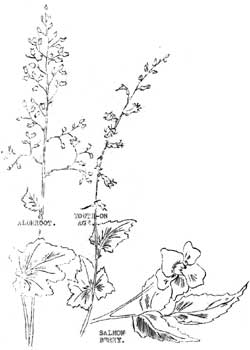
 | ||||||||

The legions of spring, that have been storming the gates of the park for many weeks, have now become definitly entrenched in this area. On the heels of the "advance guard" have come a host of familiar features that gives evidence that this favored season is with us again at last. From the marshes come the throaty chorus of frogs; dark woodland trails ring with the vivacious melody of the Western Winter Wren; balmy breezes and brilliant sunshine disolve the snow drifts in the "high country" and release such captured moisture in the form of numerous rivulets that prattle down the hillsides to larger streams in the principal valleys; fish poles are unlimbered and bears once again roam about in their characteristic cantankerous manner. In short - spring is here. In no phase of natural history is this seasonal advance so noticeable as in the case of the flowers. For nearly two weeks flowers have been in bloom at Paradise Valley on the numerous "islands" of the land that have appeared in the snow that, for this season, is far less than has been the case for several years. While these are negligible in number they are nevertheless indicative of the floral glory of these meadows later in the summer. In the lowlands we find a great number of interesting plants in bloom. In fact they are coming in so fast that we are having a hard time keeping up with their progress. Sweet-After-Death clothes the floor of the forest near the park boundaries and the blossom of the Star Flower adds its touch of beauty to the same scene. Various species of violets and color to the somber green of the deep forests while in open sunny spots along the highways we note patches of Canadian Dogwood or Bunchberry, Trillium, Forest Anemone, the familiar the unsavory Skunk Cabbage, Red Elder and the brilliant red of the Flowering Currant. 
At Longmire, in dry soils that have had the advantage of the sunny days of spring one finds great masses of the spectacular Bear Grass, Squaw Grass or Indian Basket grass - it has a variety of common names. So abundant is this flower at this point now that we suspect another "Bear Grass Year". If so visitors to the park who appreciate a floral display par excellence will find much to delight their eyes in such places as the "Silver Forest" where this plant abounds. Alumroot and Youth-on-age - two members of the Saxifrage family - are familiar sights along the Trail of the Shadows and similar locations and bordering the tumultuous Nisqually River, along the rocky walls that flank this stream in places, we find the bell-like blossoms of the Bear Berry, better known by its tongue twisting name of Kinnikinnik. The flowers of the Salmonberry are still to be found in numerous places but at the lower elevations we now find them in fruit. The trees, too, contribute their share. One finds both staminate and pistillate flowers of all our arboreal species abundant and conspicuous at this time and, of course, they take their place among other flowers in the flower display on the porch of the museum. Yes, the flowers are making the most of an early and favorable spring. (C.F.B.) | ||||||
| <<< Previous | > Cover < | Next >>> |
vol12-6d.htm
01-Mar-2002